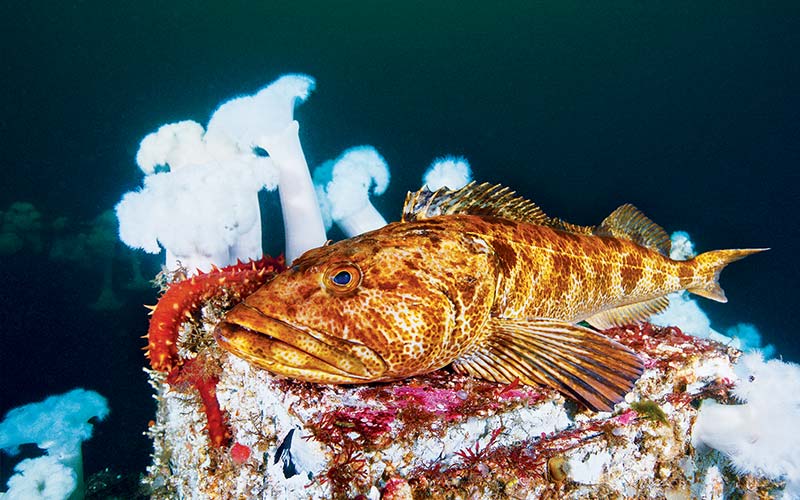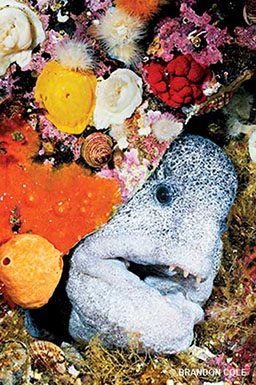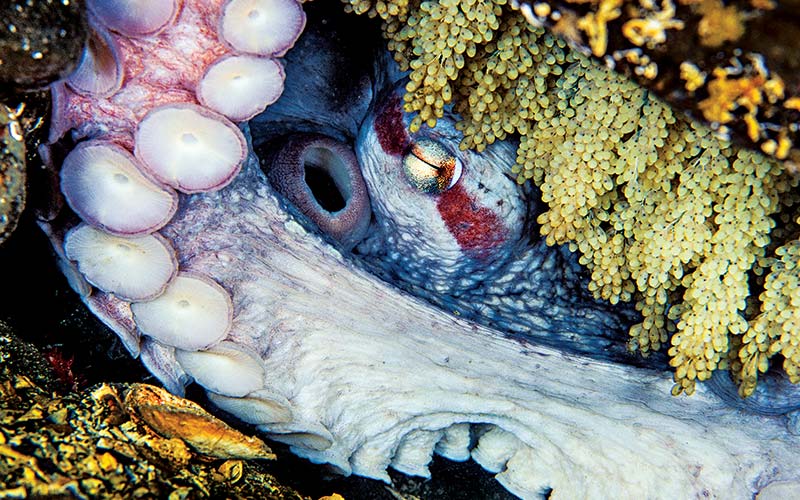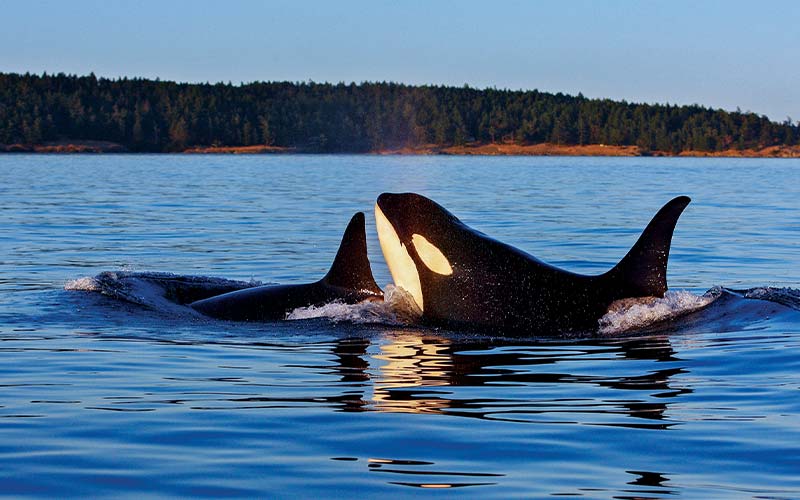The cool, current-swept waters surrounding British Columbia’s Vancouver Island are home to stunning beauty and a remarkable diversity of marine creatures. It’s a rugged wilderness where orcas cruise through island mazes, photogenic fish lounge on resplendent rocky reefs, and strange beasts, including the world’s largest octopus, creep about in the green gloom. Sheer walls are carpeted with invertebrates; they pulse with life, while numerous shipwrecks rest silently in liquid graves. It’s no wonder many proclaim this one of the best cold-water destinations on the planet.

Vancouver Island diving hotspots include Nanaimo on the island’s eastern shore, Port Hardy on the north, Barkley Sound guarding the western flank and Victoria nestled in the south. Like multihued precious stones circling a crown, each sparkles a different color, and each has its own character and charm.
Nicknamed “The Harbor City,” Nanaimo is an ideal location for launching a diving expedition. You can drive (via ferry) or fly to Nanaimo; its numerous pubs and eateries, diver-friendly accommodations, entertainment and attractions promise a fun-filled stay. Of course, some of the best attractions are underwater.
The HMCSSaskatchewan, a 366-foot-long Mackenzie-class destroyer escort, is British Columbia’s most visited dive site; hundreds of thousands of dives have been logged on it by divers from around the globe. Ocean alchemy has transformed 3,000 tons of metal into a living fortress, a multistory magnet for marine life. Metridium giant anemones, the Northwest’s totem cnidarians, crowd the decks fore, aft and amidships — newly recruited ghost soldiers standing at attention. Shadowy recesses provide lurking grounds for gangs of rockfish. Scuttling over everything are crabs and shrimps, grunts in Neptune’s navy.
We target the forward guns for inspection. The once formidable weaponry now lies at 100 feet and is camouflaged in inverts. We fin along past primitive feather stars that feed atop railings and peach-painted tunicates stuck to the steel hull. My wide-angle lens pulls me upward through a cloud of glittering baitfish and toward the bridge at 65 feet. A rogue lingcod bursts forth from a window to charge past me. He’s too fast for my trigger finger; I can only watch and wish as the brute, as big as my leg and probably 50 pounds, glides down into an open hatchway to vanish in the wreck’s belly.
We poke heads into compartments and cabins and then ascend to the radar platform at 45 feet. This great monolithic structure sits atop the main mast and has an interesting profile that, from a certain angle, reminds me of a submarine. It’s a great photo op for the fisheye lens. All too soon our time is up. Following an ascent line back to the surface world, we pause to enjoy a mellow safety stop in the company of hundreds of tiny jellyfish that drift past on their way to somewhere.
The Artificial Reef Society of British Columbia sank the Saskatchewan as part of an ambitious program, still alive today, that has downed six ships and a plane in the name of dive tourism. The warship rests in 130 feet off the east side of Snake Island just a few miles outside of Nanaimo’s Departure Bay. I’ve visited there many times over the years, starting with the ship’s 1997 baptism amid great pomp and circumstance. Hundreds of spectator craft floated nearby, and horns blared in celebration as the winner of an international “push the button” contest claimed the glory of sinking her. I must say the Saskatchewan is looking great as a teenager. She’s easy to get to know, too. Divers generally find it easy to keep their bearings as they navigate the structure, and currents at the site are generally mild.

The Saskatchewan serves as an ideal second wreck dive following a first tank on the HMCSCape Breton. A Cape-class escort maintenance ship, the Cape Breton is 440 feet long and sits upright on a silty, 130-foot-deep bottom. Like the Saskatchewan, it was painstakingly prepared before sinking, with hatches, doors and dangerous rigging removed and holes cut in the hull to provide light and entry/exit points for divers trained in wreck penetration. As I’m without advanced shipwreck training, I stick to the exterior scenery, mostly staying above the main deck at 110 feet. Those with the appropriate skills and experience should consider buddying up with a local guide to explore signposted interior rooms, including the sick bay, officer’s wardroom and even the bakery. For those who really know their way around overhead environments, the engine room beckons at 150 feet. Yes, it’s actually below the seafloor; the Cape Breton‘s keel plowed deeply into the mud when it was sunk in 2001.

Another popular option for a fun, two-splash, half-day combo is to satisfy one’s shipwreck fix first and then go for a relaxing snorkel with the harbor seals that usually hang around in the shallows of Snake Island. Some of these plump pinnipeds may be overcome by curiosity and swim right up to nuzzle your camera or tug on your fins. Divers with a technical bent might choose to begin the day by observing the eerie, flowstonelike formations of deepwater cloud sponges below 130 feet along Snake Island’s wall. Cream-colored assemblages of this rare glass sponge can grow to 8 feet in diameter and are thought to live for hundreds of years. Look closely among the convoluted branches and brainlike folds to find spindly-armed spider crabs and juvenile quillback rockfish. It’s easy to go very deep along this precipice — mixed-gas rebreather divers stage 300-foot jumps here — so keep your wits about you.
No British Columbia (BC) dive trip is complete without some bottom time spent in the company of wolf eels. Their flabby-jowled faces and buck-toothed smiles are most endearing. If these creatures had lungs, I’d gladly have them guarding my house instead of Fido. Clark Rock and Breakwater Island usually have a number of wolf eels in residence. During winter months you may even find a mated pair wrapped around a volleyball-sized clutch of pink eggs.
For those on a tight budget, there is some excellent shore diving in the Nanaimo area. Madrona Point, a scenic drive up the coast near Parksville, has a sloping rock wall favored by giant pacific octopuses. Though usually found wedged into nooks and crannies with just an eyeball or a bit of suckered tentacle visible, these super-sized cephalopods are occasionally sighted out and about, hunting for crabs. Orlebar Point, on Gabriola Island’s northern tip, is a quick ferry ride and drive from Nanaimo proper. A compass heading of 20 degrees will take you past kelp gardens to an artfully sculpted sandstone wall dropping from 45 feet to beyond the century mark. Rockfish (black, quillback and even tiger varieties) and a healthy assemblage of encrusting invertebrates (anemones, hydrocoral, sponges, bryozoans, sea squirts, sponges) await. When I’m armed with a supermacro lens I search for candy-stripe shrimp on the snakelocks anemones.
Gabriola Passage and Dodd Narrows are excellent pass dives. Dodd is my favorite Nanaimo reef dive, but because of heavy commercial boat traffic in the summer I play it safe and dive it only in the fall. Dodd has a maximum tidal current speed of more than 9 knots(!). Today we have a short, 25-minute window before the current — now just a gentle breeze — will pull us through the narrows like leaves caught up in an autumn gale. That will be just enough time to scout around a little before we give ourselves over to the outgoing tide for a half-mile-long ride through a kaleidoscope. Pick-up won’t be a problem; the boat captain will drift with us, following our bubbles.

We gear up with record speed, backroll overboard and plummet down the wall. Hovering at 70 feet and kicking to hold position, the canyon floor 20 feet below us is a snow-covered field of frilly anemones, their cauliflowerlike crowns bowed reverently to the current. To one side, high-rise barnacle condos bustle with sculpin and crustacean tenants; to the other there’s a mega-clumping of red, green and tan Tealia anemones. Above, a pile of purple ochre starfish are nestled among yellow sponges. We cannot spot bare rock in any direction. Life is stacked upon life in a vibrant collage of eye-popping color.
With the current quickly awakening, we ascend to 35 feet and tuck in behind a projecting buttress to gain a few more minutes for 60mm macro photos in the partially sheltered eddy. Quillback rockfish dart out from under a ledge whose ceiling is covered with scallops as big as Frisbees. Surfperches parade back and forth over a bed of green and purple aggregating anemones. Our exhaust bubbles swirl upward wildly, only to be obliterated into a frothy, aerated cloud as they meet with the current.
The maelstrom is building. The fronds of bull kelp overhead are laid over and waving like streamers. We begin to surge to and fro as the current’s unseen claws reach for us. It’s time. Smiling at each other, we push off from the wall out into the jet stream, and the ride begins.

How To Dive It

CONDITIONS
Nanaimo’s location on the eastern side of 300-mile-long Vancouver Island means it’s largely protected from Pacific storms. Diving is possible year-round. Sea temperatures range from 45°F to 55°F, and visibility from 20 to 80 feet. In general, fall and winter deliver the best visibility, and summer and fall the best topside weather. With dozens of dive sites, there’s something for divers of all skill levels.
GETTING THERE
By ferry: BC Ferries has numerous sailings daily from Vancouver and Tsawwassen over to Nanaimo (www.bcferries.com).
By air: Fly to Nanaimo (YCD) from Vancouver (YVR).
© Alert Diver — Q3 Summer 2013